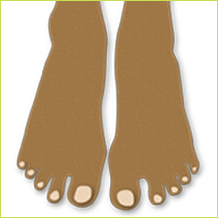What percentage of your body's bones are in your feet?
b. 15%
c. 25%
d. 40%
Answer
Match the foot problem to its description.
Corns and calluses
Bone spurs
Bunions
Hammertoes
a. Calcium bumps that grow on the bones of your feet
b. A skin infection caused by a virus
c. Bony bump on the side of the big toe
d. When a toe is bent upward at the middle joint
e. Protective layers of thick, hardened skin
Answer
Plantar warts (b) To help prevent plantar warts, never walk barefoot in public places. The virus that causes these warts is often found in warm, wet places such as showers, locker rooms, and public swimming pools. These warts may need to be removed by a doctor.
Corns and calluses (e) When the bony parts of your feet rub against your shoes, you may get corns and calluses. Wearing comfortable shoes or using special pads in your shoes may help prevent corns and calluses, or help them go away. If a corn or callus is painful, it's best to call your doctor rather than use over-the-counter treatments.
Bone spurs (a) Bone spurs are caused by muscle strain in the feet. Standing for long periods of time, wearing badly fitting shoes, and being overweight can make bone spurs worse. If you have a painful bone spur, foot supports, heel pads, and heel cups may help.
Hammertoes (d) Hammertoes may be caused by shoes that are too tight, or by muscle and nerve damage (often as a result of diabetes, stroke, or arthritis). Wearing comfortable shoes or foot pads may help, although sometimes surgery is needed.
Bunions (c) A bunion pushes the big toe against the other toes, and the resulting pressure can be painful. Bunions are often genetic, but they can also be caused by too-tight shoes, injury, or certain medical conditions. Wearing wider shoes, taping the foot, or bunion pads may help. In more serious cases, physical therapy or surgery may be needed.
When shopping for shoes, which of the following should you NOT do?
b. Have your feet measured every time you buy shoes.
c. Buy shoes for your biggest foot.
d. Buy shoes that will stretch as you wear them.
Answer
Which of the following may show up first in the feet?
b. Diabetes
c. Kidney disease
d. Anemia
e. All of the above





